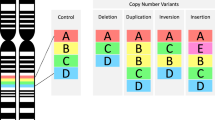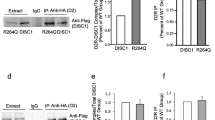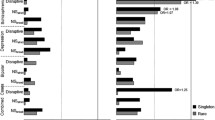Straub et al. (2002) recently identified the 6p22.3 gene dysbindin (DTNBP1) through positional cloning as a schizophrenia susceptibility gene. We studied a rare cohort of 102 children with onset of psychosis before age 13. Standardized ratings of early development, medication response, neuropsychological and cognitive performance, premorbid dysfunction and clinical follow-up were obtained. Fourteen SNPs were genotyped in the gene DTNBP1. Family-based pairwise and haplotype transmission disequilibrium test (TDT) analysis with the clinical phenotype, and quantitative transmission disequilibrium test (QTDT) explored endophenotype relationships. One SNP was associated with diagnosis (TDT p=.01). The QTDT analyses showed several significant relationships. Four adjacent SNPs were associated (p values=.0009–.003) with poor premorbid functioning. These findings support the hypothesis that this and other schizophrenia susceptibility genes contribute to early neurodevelopmental impairment.
Similar content being viewed by others
References
Abecasis G. R., Cardon L. R., Cookson W. O., (2000). A general test of association for quantitative traits in nuclear families American Journal of Human Genetics 66(1):279–292
Abecasis G. R., Cherny S. S., Cookson W. O., Cardon L. R., (2002). Merlin–rapid analysis of dense genetic maps using sparse gene flow trees Nature Genetics 30(1):97–101
Addington A. M., Gornick M., Sporn A. L., Gogtay N., Greenstein D., Lenane M., et al., (2004). Polymorphisms in the 13q33.2 gene G72/G30 are associated with childhood-onset schizophrenia and psychosis not otherwise specified Biological Psychiatry 55(10):976–980
Addington, A. M., Gornick, M., Duckworth, J., Sporn, A., Gogtay, N., Bobb, A. et al. (2005). GAD1 (2q31.1), which encodes glutamic acid decarboxylase (GAD67), is associated with childhood-onset schizophrenia and cortical gray matter volume loss Molecular Psychiatry 10(6): 581–588
Alaghband-Rad J., McKenna K., Gordon C. T., Albus K. E., Hamburger S. D., Rumsey J. M., et al., (1995). Childhood-onset schizophrenia: The severity of premorbid course Journal of the American Academy of Child and Adolescent Psychiatry 34(10):1273–1283
Asarnow R. F., Nuechterlein K. H., Fogelson D., Subotnik K. L., Payne D. A., Russell A. T., et al., (2001). Schizophrenia and schizophrenia-spectrum personality disorders in the first-degree relatives of children with schizophrenia: The UCLA family study Archives of General Psychiatry 58(6):581–588
Beiser M., Erickson D., Fleming J. A., Iacono W. G. (1993). Establishing the onset of psychotic illness American Journal of Psychiatry 150(9):1349–1354
Berument S. K., Rutter M., Lord C., Pickles A., Bailey A., (1999). Autism screening questionnaire: Diagnostic validity British Journal of Psychiatry 175:444–451
Cannon M., Walsh E., Hollis C., Kargin M., Taylor E., Murray R. M., et al., (2001). Predictors of later schizophrenia and affective psychosis among attendees at a child psychiatry department British Journal of Psychiatry 178:420–426
Cannon-Spoor H. E., Potkin S. G., Wyatt R. J., (1982). Measurement of premorbid adjustment in chronic schizophrenia Schizophrenia Bulletin 8(3):470–484
Cardon L. R., (2000). A sib-pair regression model of linkage disequilibrium for quantitative traits Human Heredity 50(6):350–358
Childs B., Scriver C. R., (1986). Age at onset and causes of disease Perspect Biol Med 29(3 Pt 1):437–460
Cornblatt B., Lencz T., Obuchowski M., (2002). The schizophrenia prodrome: treatment and high-risk perspectives Schizophrenia Research 54(1–2):177–186
Done D. J., Crow T. J., Johnstone E. C., Sacker A., (1994). Childhood antecedents of schizophrenia and affective illness: Social adjustment at ages 7 and 11 British Medical Journal 309(6956):699–703
Dudbridge F., (2003). Pedigree disequilibrium tests for multilocus haplotypes Genetic Epidemiology 25(2):115–121
Hollis C., (1995a). Child and adolescent (juvenile onset) schizophrenia. A case control study of premorbid developmental impairments British Journal of Psychiatry 166(4):489–495
Hollis C., (1995b). Childhood antecedents of schizophrenia. Difference in antecedents between sexes may not be genuine British Medical Journal 310(6971):57
Jones P., Rodgers B., Murray R., Marmot M., (1994). Child development risk factors for adult schizophrenia in the British 1946 birth cohort Lancet 344(8934):1398–1402
Kendler, K. S., Prescott, C. A., Myers, J., & Neale, M. C. (2003). The structure of genetic and environmental risk factors for common psychiatric and substance use disorders in men and women. Archives of General Psychiatry 60(9): 929–937
Kirov G., Ivanov D., Williams N. M., Preece A., Nikolov I., Milev R., et al., (2004). Strong evidence for association between the dystrobrevin binding protein 1 gene (DTNBP1) and schizophrenia in 488 parent-offspring trios from Bulgaria Biological Psychiatry 55(10):971–975
Kumra S., Frazier J. A., Jacobsen L. K., McKenna K., Gordon C. T., Lenane M. C., et al., (1996). Childhood-onset schizophrenia. A double-blind clozapine-haloperidol comparison Archives of General Psychiatry 53(12):1090–1097
Lewis C. M., Levinson D. F., Wise L. H., DeLisi L. E., Straub R. E., Hovatta I., et al., (2003). Genome scan meta-analysis of schizophrenia and bipolar disorder, part II: Schizophrenia American Journal of Human Genetics 73(1):34–48
Li, W., Zhang, Q., Oiso, N., Novak, E. K., Gautam, R., O'Brien, E. P., et al. (2003). Hermansky-Pudlak syndrome type 7 (HPS-7) results from mutant dysbindin, a member of the biogenesis of lysosome-related organelles complex 1 (BLOC-1). Nature Genetics 35(1): 84–89
Loebel A. D., Lieberman J. A., Alvir J. M., Mayerhoff D. I., Geisler S. H., Szymanski S. R., (1992). Duration of psychosis and outcome in first-episode schizophrenia American Journal of Psychiatry 149(9):1183–1188
Nicolson R., Brookner F. B., Lenane M., Gochman P., Ingraham L. J., Egan M. F., et al., (2003). Parental schizophrenia spectrum disorders in childhood-onset and adult-onset schizophrenia American Journal of Psychiatry 160(3):490–495
Nicolson R., Rapoport J. L., (1999). Childhood-onset schizophrenia: Rare but worth studying Biological Psychiatry 46(10):1418–1428
Schwab S. G., Knapp M., Mondabon S., Hallmayer J., Borrmann-Hassenbach M., Albus M., et al., (2003). Support for association of schizophrenia with genetic variation in the 6p22.3 gene, dysbindin, in sib-pair families with linkage and in an additional sample of triad families American Journal of Human Genetics 72(1):185–190
Skuse D. H., (2001). Endophenotypes and child psychiatry British Journal of Psychiatry 178:395–396
Sporn A. L., Addington A. M., Gogtay N., Ordonez A. E., Gornick M., Clasen L., et al., (2004). Pervasive developmental disorder and childhood-onset schizophrenia: Comorbid disorder or a phenotypic variant of a very early onset illness? Biological Psychiatry 55(10):989–994
Sporn, A., Greenstein, D., Gogtay, N., Sailer, F., Hommer, D. W., Rawlings, R. et al. (2005). Childhood-onset schizophrenia: Smooth pursuit eye-tracking dysfunction in family members Schizophrenia Research 73(2–3) :243–252
St George-Hyslop P. H., (2000). Genetic factors in the genesis of Alzheimer’s disease Annals of the New York Academy of Sciences 924:1–7
Straub, R. E., Jiang, Y., MacLean, C. J., Ma, Y., Webb, B. T., Myakishev, M. V., et al. (2002). Genetic variation in the 6p22.3 gene DTNBP1, the human ortholog of the mouse dysbindin gene, is associated with schizophrenia. American Journal of Human Genetics, 71(2): 337–348
Tang J. X., Zhou J., Fan J. B., Li X. W., Shi Y. Y., Gu N. F., et al., (2003). Family-based association study of DTNBP1 in 6p22.3 and schizophrenia Molecular Psychiatry 8(8):717–718
Van Den Bogaert, A., Schumacher, J., Schulze, T. G., Otte, A. C., Ohlraun, S., Kovalenko, S., et al. (2003). The DTNBP1 (dysbindin) gene contributes to schizophrenia, depending on family history of the disease. American Journal of Human Genetics 73(6): 1438–1443
Weinberger D. R., (1987). Implications of normal brain development for the pathogenesis of schizophrenia Archives of General Psychiatry 44(7):660–669
Weinberger D. R., (1999). Schizophrenia: New phenes and new genes. Biological Psychiatry 46(1):3–7
Weinberger D. R., Egan M. F., Bertolino A., Callicott J. H., Mattay V. S., Lipska B. K., et al., (2001). Prefrontal neurons and the genetics of schizophrenia Biological Psychiatry 50(11):825–844
Williams N. M., Preece A., Morris D. W., Spurlock G., Bray N. J., Stephens M., et al., (2004). Identification in 2 independent samples of a novel schizophrenia risk haplotype of the dystrobrevin binding protein gene (DTNBP1) Archives of General Psychiatry 61(4): 336–344
Acknowledgements
The authors would like to thank all of the families who participated in the study.
Author information
Authors and Affiliations
Corresponding author
Rights and permissions
About this article
Cite this article
Gornick, M.C., Addington, A.M., Sporn, A. et al. Dysbindin (DTNBP1, 6p22.3) is Associated with Childhood-Onset Psychosis and Endophenotypes Measured by the Premorbid Adjustment Scale (PAS). J Autism Dev Disord 35, 831–838 (2005). https://doi.org/10.1007/s10803-005-0028-3
Published:
Issue Date:
DOI: https://doi.org/10.1007/s10803-005-0028-3




